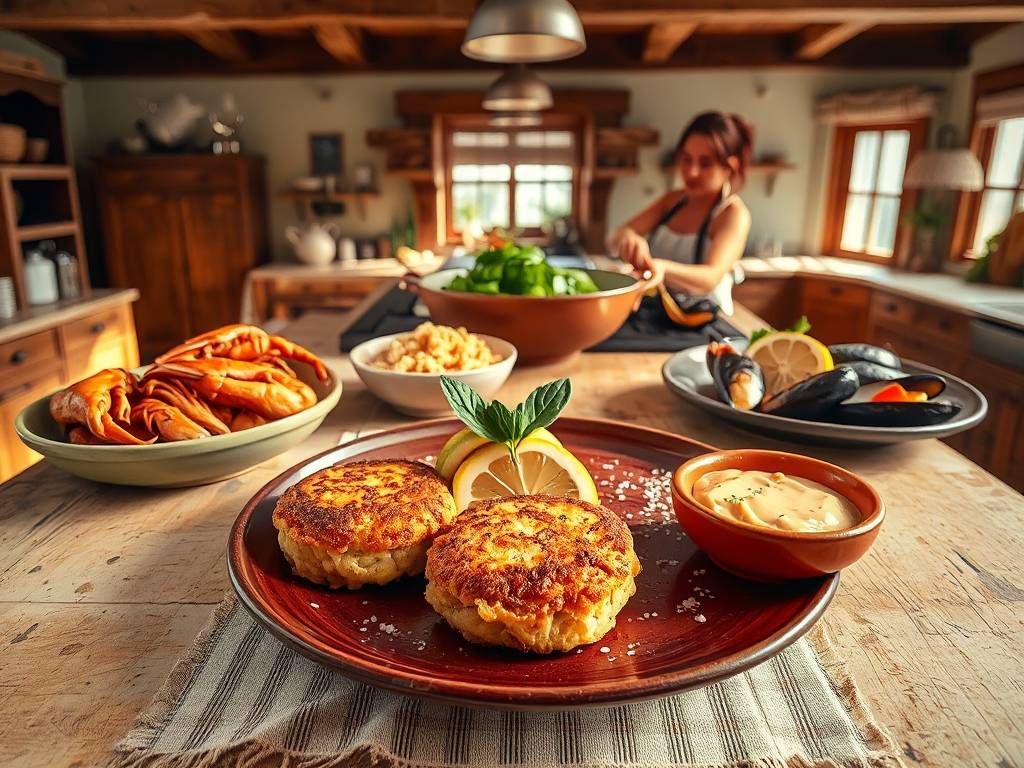The Art of Crafting Perfect Crab Cakes with Zesty Remoulade and Lemon
There's something undeniably luxurious about biting into a perfectly cooked crab cake - that golden-brown exterior giving way to a tender, flavorful interior bursting with sweet crab meat. When paired with a tangy remoulade sauce and a squeeze of fresh lemon, this dish transforms from simple seafood preparation to culinary masterpiece. Whether you're planning an elegant dinner party or simply treating yourself to something special, mastering crab cakes is a skill worth acquiring.
Understanding Your Main Ingredient: The Crab
The foundation of exceptional crab cakes lies in selecting the right crab meat. While various types of crab can be used, lump crab meat from blue crabs remains the gold standard for its sweet flavor and substantial texture. Look for fresh-picked crab meat when possible, though high-quality pasteurized canned crab can work well too.
When handling crab meat, gentle is the operative word. Pick through the meat carefully to remove any stray shell fragments without breaking up those beautiful lumps. The goal is to preserve as much of the crab's natural texture as possible, as overworking the meat will result in dense, rubbery cakes.

Crafting the Perfect Crab Cake Mixture
The secret to outstanding crab cakes lies in the balance between binder and crab. Too much filler and you'll mask the crab's delicate flavor; too little and your cakes may fall apart during cooking. Here's my carefully developed ratio:
For every pound of crab meat, you'll need:
- 1/4 cup mayonnaise (preferably Duke's or homemade)
- 1 large egg, lightly beaten
- 1 tablespoon Dijon mustard
- 1 teaspoon Worcestershire sauce
- 1/2 cup panko breadcrumbs (plus extra for coating)
- 2 tablespoons finely chopped fresh parsley
- 1 tablespoon minced chives
- 1 teaspoon Old Bay seasoning
- 1/4 teaspoon smoked paprika
- Salt and freshly ground black pepper to taste
Combine all ingredients except the crab in a large bowl, mixing until just incorporated. Then, using a gentle folding motion, incorporate the crab meat, being careful not to break up the lumps. The mixture should hold together when pressed but still be loose enough to see distinct pieces of crab.
Forming and Chilling: The Critical Step Too Many Skip
Using a 1/3 cup measure or ice cream scoop, portion the mixture into equal amounts. Gently form each portion into a patty about 1-inch thick, handling as little as possible. Place the formed cakes on a parchment-lined baking sheet and refrigerate for at least 1 hour (or up to 4 hours). This chilling period is non-negotiable - it allows the breadcrumbs to absorb moisture and the cakes to firm up, preventing them from falling apart during cooking.
Cooking Methods: Pan-Frying Perfection
While baking is an option, pan-frying delivers that irresistible crispy exterior that makes crab cakes truly special. Heat a combination of butter and neutral oil (like grapeseed or canola) in a heavy skillet over medium heat. The butter adds flavor while the oil raises the smoke point.
When the fat shimmers, carefully add the chilled crab cakes, being careful not to overcrowd the pan. Cook for 3-4 minutes per side until deeply golden brown. Resist the urge to press down on the cakes - this will only squeeze out moisture and make them dense. Work in batches if necessary, keeping finished cakes warm in a low oven.
Creating the Perfect Remoulade Sauce
No crab cake is complete without its perfect partner: remoulade. This classic French sauce has been adopted and adapted by countless cultures, but for crab cakes, we want a version that complements without overwhelming.
My go-to recipe combines:
- 1 cup mayonnaise
- 2 tablespoons Creole mustard (or whole grain Dijon)
- 1 tablespoon prepared horseradish
- 1 tablespoon capers, drained and chopped
- 2 cornichons or small dill pickles, finely minced
- 1 small shallot, minced
- 1 tablespoon fresh parsley, chopped
- 1 teaspoon lemon juice
- 1/2 teaspoon smoked paprika
- 1/4 teaspoon cayenne pepper (optional)
- Salt and freshly ground black pepper to taste
Combine all ingredients in a bowl and whisk until smooth. For best flavor, make the remoulade at least an hour before serving to allow the flavors to meld. Store covered in the refrigerator until ready to use.
The Lemon Element: More Than Just a Garnish
That wedge of lemon served alongside crab cakes isn't merely decorative - it serves the crucial purpose of cutting through the richness of both the cake and the remoulade. For the best experience, use room temperature lemons (they yield more juice) and roll them firmly on the counter before cutting to maximize juice extraction.
Consider also incorporating lemon zest into both your crab cake mixture and remoulade sauce for an extra layer of citrus aroma. When serving, encourage guests to squeeze the lemon over their crab cakes just before eating to maintain the crisp texture.
Plating and Presentation
Beautiful food tastes better, and crab cakes deserve an elegant presentation. Place a generous dollop of remoulade on the plate, using the back of a spoon to create a swoosh. Position the crab cake slightly off-center, garnishing with microgreens or additional chopped herbs. Add the lemon wedge artfully to the side, and consider serving with a simple arugula salad dressed with lemon vinaigrette to cut the richness.
Wine Pairings and Accompaniments
The rich, slightly sweet flavor of crab cakes pairs wonderfully with crisp, acidic white wines. Consider a Sauvignon Blanc from New Zealand, with its vibrant citrus notes, or a traditional Chablis from France. For beer lovers, a clean pilsner or wheat beer provides refreshing contrast.
For side dishes, keep things simple to let the crab cakes shine. A light coleslaw, roasted asparagus, or heirloom tomato salad all make excellent companions. Avoid heavy starches like mashed potatoes that might compete with the delicate crab flavor.
Troubleshooting Common Crab Cake Issues
Even experienced cooks can encounter challenges with crab cakes. If your cakes are falling apart, you may need more binder or longer chilling time. If they're too dense, you're likely overmixing or using too much filler. Soggy centers usually indicate either undercooking or overcrowding the pan, which lowers the temperature and causes steaming rather than frying.

For those concerned about the cakes holding together, you can add an extra tablespoon of breadcrumbs or refrigerate them longer. Some cooks swear by adding a teaspoon of cornstarch to the mixture for additional stability without affecting flavor.
Sustainable Seafood Considerations
As seafood lovers, it's our responsibility to make environmentally conscious choices. Look for crab meat certified by organizations like the Marine Stewardship Council, and consider domestic blue crab over imported varieties to reduce your carbon footprint. Many fisheries now use traps that minimize bycatch and habitat damage - supporting these practices helps ensure we can enjoy crab for generations to come.
Final Thoughts
Mastering crab cakes with remoulade and lemon is about understanding balance - between crab and binder, between crisp exterior and tender interior, between rich cake and bright sauce. With quality ingredients, gentle handling, and proper technique, you can create restaurant-quality crab cakes in your own kitchen that will impress even the most discerning seafood connoisseur.
Remember that cooking is both art and science - don't be afraid to adjust seasonings to your personal taste, and most importantly, enjoy the process. The satisfaction of creating something beautiful and delicious from simple ingredients is, after all, what cooking is all about.






发表评论